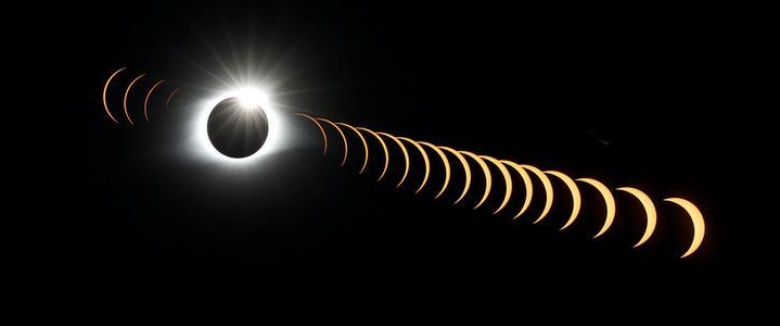
As millions of awestruck Americans cast their gaze skyward on Monday at the extraordinary sight of a total solar eclipse, one Connecticut man had his eyes set firmly on a different prize.
As millions of awestruck Americans cast their gaze skyward on Monday at the extraordinary sight of a total solar eclipse, one Connecticut man had his eyes set firmly on a different prize.
Joseph Fleming, 43, went down on one knee in the darkness near the harbor in Charleston, South Carolina, and asked Nicole Durham to marry him.
 |
| A composite image of 21 separate photographs taken with a single fixed camera shows the solar eclipse as it creates the effect of a diamond ring at totality as seen from Clingmans Dome, which at 6,643 feet (2,025m) is the highest point in the Great Smoky Mountains National Park, Tennessee, U.S. August 21, 2017. Location coordinates for this image are 35º33'24" N, 83º29'46" W. |
"The sun, the moon and my love, all in a straight line," Fleming said, laughing, after Durham, 40, said yes.
The first total eclipse in a century to sweep across the United States from coast to coast inspired Americans to make marriage proposals, hold family reunions and take time from work to witness with wonder one of the cosmos' rarest phenomena.
After weeks of anticipation, onlookers from Oregon to South Carolina whooped and cheered as the moon blotted out the sun, transforming a narrow band of the United States from day to night for two minutes at a time.
Even President Donald Trump stepped out of the White House to see the eclipse, though he was spotted briefly looking up without protective glasses, which can cause eye damage, as an aide yelled "Don't look!"
"It's more powerful than I expected," Robert Sarazin Blake, 40, a singer from Bellingham, Washington, said after the eclipse passed over Roshambo ArtFarm in Sheridan, Oregon. "All of a sudden you're completely in another world. It's like you're walking on air or tunneling underground like a badger."
No area in the continental United States had seen a total solar eclipse since 1979, while the last coast-to-coast total eclipse took place in 1918.
The event was expected to draw one of the largest audiences in human history, including those watching on television and online.
Some 12 million people live in the 70-mile-wide (113-km-wide), 2,500-mile-long (4,000-km-long) zone where the total eclipse appeared, while hordes of others traveled to spots along the route.
Many people trekked to remote national forests and parks of Oregon, Idaho and Wyoming. Those in cities along the path like Kansas City, Missouri, and Nashville, Tennessee, were able to simply walk outside.
The eclipse first reached "totality" - the shadow cast when the sun is completely blocked by the moon - in Oregon at 10:15 a.m. PDT (1715 GMT) and began spreading eastward.
"It just kind of tickled you all over - it was wonderful - and I wish I could do it again," said Stormy Shreves, 57, a fish gutter who lives in Depoe Bay, Oregon. "But I won't see something like that ever again, so I'm really glad I took the day off work so I could experience it."
As the sun slipped behind the moon in Sawtooth National Forest in Idaho, stars became visible, coyotes howled and the temperature dropped precipitously.
The phenomenon took its final bow at 2:49 p.m. EDT (1849 GMT) near Charleston.
Monday's excitement led music lovers to stream Bonnie Tyler's "Total Eclipse of the Heart," pushing it to the top of Apple's iTunes chart 34 years after its release. Tyler herself performed the song aboard a Royal Caribbean cruise ship on Monday.
(Source: Reuters)





